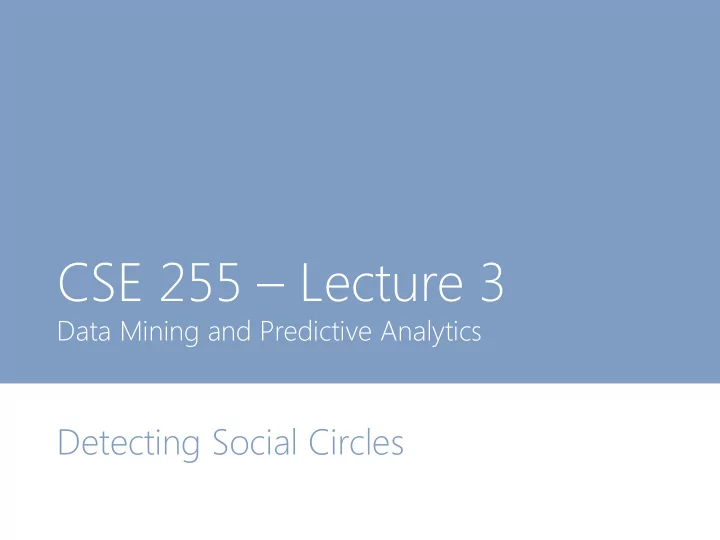

CSE 255 – Lecture 3 Data Mining and Predictive Analytics Detecting Social Circles
Social circles
Communities in ego-networks “What are the interest groups or communities among my friends?” NIPS 2012, TKDD 2014 (w/ Leskovec)
Data Why are we friends (facebook)? 200,000 user profiles, in 5,000 hand-labeled communities (we also collect similar data from Google+ and twitter) Facebook app: http://snap.stanford.edu/socialcircles/
Statistics of social circles Disjoint communities Hierarchical communities (from Adamic & Glance, 2005) (from Clauset et al., 2005)
Existing approach Proposal: Edges are more likely between nodes that have many communities in common Task: Identify communities that maximize the likelihood of the graph
Existing approach 1. Edges belong inside communities 2. Non-edges belong outside communities Circles are highly connected people who also have common attributes Q: Does this user belong in this circle? A: Yes, because they attended the same high-school
Constructing features from profiles = [0,0,0,1,1,0,0,0,0,0,1,0,0,0,0,0,0,0,0,0,0,1,0,0,0,0]
A better model Proposal: Learn a similarity metric for each circle: which attributes do x and y have in common? which attributes are relevant to circle k ? Task: Reward edges for belonging to a circle only if they have the relevant attributes in common
Model fitting Repeat steps (1) and (2) until convergence: Step 1: Find circles from circle parameters (solved via pseudo-boolean optimization) Step 2: Find circle (solved via gradient ascent using L-BFGS) parameters (solved using gradient ascent) from circles
Outcomes – applications (Goal 1) Circle prediction: 43% more accurate than alternatives on facebook (26% on Google+, 16% on twitter) blue/grey = true positive/negative red/yellow = false positive/negative
Outcomes – understanding (Goal 2) Circle recommendation: We also generate explanations as to why we recommended each circle to the user
Follow-up: scalability Q: How can we handle attributes in million-node networks? A: Via a continuous relaxation with convex subproblems We apply our model to large networks of Google+ users, flickr users, and Wikipedia articles Two “communities” of wikipedia pages on similar topics ICDM 2013 (w/ Yang & Leskovec)
Follow-up: directed networks Directed networks have different semantics than undirected networks and should be modeled differently: • twitter and Google+ communities are people with common followers • Applied to networks from other domains, e.g. PPI and predator-prey networks photo courtesy of Hector Garcia Molina WSDM 2014 (w/ Yang & Leskovec)
Conclusion • Existing models tend to focus on graph topology (community detection) or on node features (clustering), but not how the two interact in concert • To detect social circles we need to use both – to find communities that are densely linked around particular attributes that are important to each user • Joint work with Jure Leskovec
Recommend
More recommend